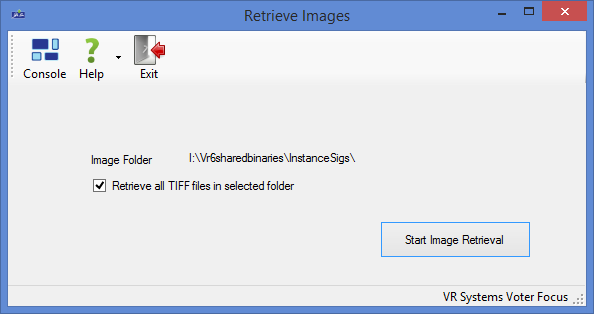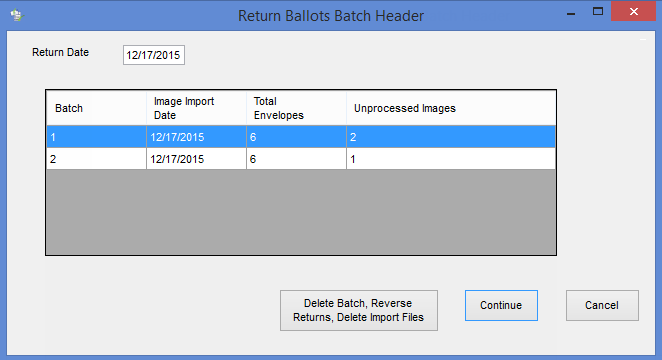Return Mail Ballots Processed by a Mail Balloting System
This topic explains how to process returned mail ballots after the envelopes containing the ballots have undergone return processing on a third-party mail balloting system such as ES&S VoteRemote™.
It is not necessary to have the returned envelopes physically in hand to return them through Voter Focus. The information in the files provided by the mail balloting system are sufficient to process the returns. The only time you need a physical envelope is when the envelope cannot be processed by the mail balloting system or the mail ballot package was returned as undeliverable by the postal service. See How to Handle Undeliverable Mail Ballots and Returns Unable to Be Processed by Mail-Balloting Systems for instructions on recording the return of such ballots.
If the mail balloting system is equipped with an automated signature recognition feature, return processing on the mail balloting system includes scanning of the signature on the return envelope and comparison with the reference signatures exported from the county registration database. The system retrieves the reference file having the same bar code number as the return envelope and compares the instance signature on the return envelope with the reference signature exported from the county database.
To each return, the mail balloting system assigns a signature verification result code. The possible codes are:
0—Signature unable to be processed. Assigned if the county does not use the automated signature recognition feature.
1—Signature is verified. The instance signature matches the reference signature.
2—Signature could not be verified. For example, the instance signature does not appear to match the reference signature or no reference signature was available for that voter, so Voter Focus user must compare the two signatures manually.
If the county does not use this feature, the return signatures are simply scanned by the mail balloting system and passed to Voter Focus for manual verification (that is, visual verification by an elections worker).
Regardless of whether the automated signature recognition feature is used, the mail balloting system prints a return trace code on the return envelope. This code consists of:
- The bar code number.
- The tray number, which will become the Voter Focus return ballots batch number.
Note: The maximum length of the Voter Focus return ballots batch number is 5 characters. So the maximum tray number that Voter Focus can handle is 99,999.
- A sequence number within the tray.
The mail balloting system creates two files for each tray/batch of returned envelopes:
- A multi-page TIFF file containing images of all envelope signatures in the tray/batch.
- A comma delimited text file that lists—for each returned ballot—the voter registration ID, the signature verification result, the tray/batch number, and a sequence number indicating the return’s position in the tray/batch.
The two files have the same name with the extensions TIF and TXT, respectively. Contact your third-party vendor for instructions on locating these files on the mail balloting system.
- Copy the two files for each batch (the TIF and the TXT files) from the mail balloting system to a network location where they can be read by Voter Focus. We recommend you copy them to this location:
I:\Vr6Sharedbinaries\InstanceSigs
All files should be copied to the same folder. If the \InstanceSigs folder does not already exist, you will need to create it.
- Ensure that the election you want is in focus.
- Go to Vote By Mail > Retrieve Return Images.
- On the Windows Open dialog, navigate to the folder where you copied the two files for each batch from the mail balloting system (I:\Vr6Sharedbinaries\InstanceSigs), highlight the TIF file, and click Open.
If the check box Retrieve all TIFF files in the selected folder is selected, the program will import all TIF files in the \Instance Sigs folder, even though you only selected one TIF file on the Open dialog. If you clear this check box, the program will import only the TIF file you selected.

- Click Start Image Retrieval. When it's done, you'll see a message indicating how many images were retrieved into Voter Focus. Click OK. You'll then be asked if you want to see a retrieval report. If you click Yes, you will see a Crystal Report onscreen listing the retrieve images by Application ID.

- Click Exit to dismiss the Retrieve Images dialog.
- Go to Vote By Mail > Return Ballots from Envelope Reader.
- On the Return Ballots Batch Header dialog, you'll see a list of the batches of processed by the third-party mail balloting system that contain ballots awaiting return processing in Voter Focus. In the Return Date field, accept today's date or enter another date to be recorded as the ballot return date. Highlight the batch you want to work on and click Continue.

- On the Return Ballots dialog, click Get Next Record. The record for the first ballot in the tray/batch will appear along with the verification information from the mail balloting system.
If the signature was verified by the mail balloting system's automated signature recognition feature and Voter Focus detects nothing that would need a review (for example, the voter has already voted or is required to show a photo ID), you will not see a record of the return. Voter Focus processes it as Accepted, and the next return is obtained from queue. No effort is required on the user’s part. You should be aware, however, that this background processing might be perceived by users as a system delay, particularly if there are multiple returns to be processed that require no user intervention.
If all returns in the batch were verified by the mail balloting system and Voter Focus detects no issues with the return, you will see the message No Ballot Images Found. You can obtain a list of the ballots that have been processed by printing the report Envelope Reader Referred Ballots by Tray.
If a signature could not be verified by the mail balloting system or the system is not equipped with an automated signature recognition feature, the return is presented for user review. You will see the voter’s signature clip from the Voter Focus database and below it, the signature image from the return envelope. Accept or refer the return as you would normally. (See How to Record the Return of Mail Ballots for instructions.) The Canvassing Referral Sheet prints as it normally would.
- Continue processing returns until you see the message No Ballot Images Found, indicating that all files have been processed.
If a mail ballot is referred to Canvassing Board, the batch number remains the tray number from the mail balloting system. We suggest separating the referred returns in a tray from the accepted ones, tying the referred returns together, and placing them at the front of the tray. To find the return envelopes, run the report Envelope Reader Referred Ballots by Tray.
Leaving referred envelopes in the tray greatly facilitates the physical count of all returned envelopes. Because mail balloting systems limit tray sizes to a specified number of envelopes, the count in every tray except the last will be the maximum number. If referred envelopes are removed, the count in each tray will be different, and the physical count will be more time consuming.